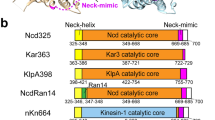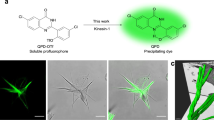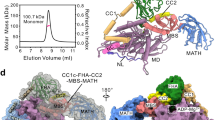Abstract
Here, using a quantitative in vivo assay, we map three regions in the carboxy terminus of conventional kinesin that are involved in cargo association, folding and regulation, respectively. Using C-terminal and internal deletions, point mutations, localization studies, and an engineered ‘minimal’ kinesin, we identify five heptads of a coiled-coil domain in the kinesin tail that are necessary and sufficient for cargo association. Mutational analysis and in vitro ATPase assays highlight a conserved motif in the globular tail that is involved in regulation of the motor domain; a region preceding this motif participates in folding. Although these sites are spatially and functionally distinct, they probably cooperate during activation of the motor for cargo transport.
This is a preview of subscription content, access via your institution
Access options
Subscribe to this journal
Receive 12 print issues and online access
$209.00 per year
only $17.42 per issue
Buy this article
- Purchase on Springer Link
- Instant access to full article PDF
Prices may be subject to local taxes which are calculated during checkout




Similar content being viewed by others
References
Howard, J. The movement of kinesin along microtubules. Annu. Rev. Physiol. 58, 703–729 ( 1996).
Vale, R. D. & Fletterick, R. The design plan of kinesin motors . Annu. Rev. Cell Dev. Biol. 13, 745– 777 (1997).
Vale, R. D., Reese, T. S. & Sheetz, M. P. Identification of a novel force-generating protein, kinesin, involved in microtubule-based motility. Cell 42, 39–50 (1985).
Brady, S. T. A novel brain ATPase with properties expected for the fast axonal transport motor. Nature 317, 73–75 (1985).
Scholey, J. M., Porter, M. E., Grissom, P. M. & McIntosh, J. R. Identification of kinesin in sea urchin eggs and evidence for its localization in the mitotic spindle. Nature 318, 483– 486 (1985).
Hirokawa, N. Kinesin and dynein superfamily proteins and the mechanism of organelle transport . Science 279, 519–526 (1998).
Amos, L. A. Kinesin from pig brain studied by electron microscopy. J. Cell Sci. 87, 105–111 ( 1987).
Hirokawa, N. et al. Submolecular domains of bovine brain kinesin identified by electron microscopy and monoclonal antibody decoration. Cell 56, 867–878 (1989).
Diefenbach, R. J., Mackkay, J. P., Armati, P. J. & Cunningham, A. L. The C-terminal region of the stalk domain of ubiquitous human kinesin heavy chain contains the binding site for kinesin light chain. Biochemistry 37, 16663–16670 ( 1998).
Yang, J. T., Saxton, W. M., Stewart, R. J., Raff, E. C. & Goldstein, L. S. B. Evidence that the head of kinesin is sufficient for force generation and motility in vitro. Science 249, 42–47 ( 1990).
Gindhart, J. G., Desai, C. J., Beushausen, S., Zinn, K. & Goldstein, L. S. B. Kinesin light chains are essential for axonal transport in Drosophila. J. Cell Biol. 141, 443–454 ( 1998).
Verhey, K. J. et al. Light-chain-dependent regulation of kinesin’s interaction with microtubules. J. Cell Biol. 143, 1053 –1066 (1998).
Rahman, A., Kamal, A., Roberts, E. A. & Goldstein, L. S. Defective kinesin heavy chain behavior in mouse kinesin light chain mutants . J. Cell Biol. 146, 1277– 1288 (1999).
Steinberg, G. & Schliwa, M. The Neurospora organelle motor: a distant relative of conventional kinesin with unconventional properties . Mol. Biol. Cell 6, 1605– 1618 (1995).
Lehmler, C. et al. Identification of a motor protein required for filamentous growth in Ustilago maydis. EMBO J. 16, 3464–3473 (1997).
Steinberg, G. A kinesin-like mechanoenzyme from the zygomycete Syncephalastrum racemosum shows biochemical similarities with conventional kinesin from Neurospora crassa. Eur. J. Cell Biol. 73, 124– 131 (1997).
Wu, Q. et al. A fungal kinesin required for organelle motility, hyphal growth and morphogenesis. Mol. Biol. Cell 9, 89–101 (1998).
Woehlke, G., Ruby, A. K., Hart, C. L., Hom-Booher, N. & Vale, R. D. Microtubule interaction site of the kinesin motor . Cell 90, 207–216 (1997).
Kuznetsov, S. A., Vaisberg, Y. A., Rothwell, S. W., Murphy, D. B. & Gelfand, V. I. Isolation of a 45 kDa fragment from the kinesin heavy chain with enhanced ATPase and microtubule binding affinities. J. Biol. Chem. 264, 589– 595 (1989).
Rice, S. et al. A structural change in the kinesin motor protein that drives motility. Nature 402, 778– 784 (1999).
Case, R. B., Pierce, D. W., Hom-Booher, N., Hart, C. L. & Vale, R. D. The directional preference of kinesin motors is specified by an element outside of the motor catalytic domain. Cell 90, 959–966 ( 1997).
Henningsen, U. & Schliwa, M. Reversal in the direction of movement of a molecular motor. Nature 389, 93–96 (1997).
Endow, S. A. & Waligora, K. W. Determinants of kinesin motor polarity. Science 281, 1200– 1202 (1998).
Romberg, L., Pierce, D. W. & Vale, R. D. Role of the kinesin neck region in processive microtubule-based motility. J. Cell Biol. 140, 1407– 1416 (1998).
Grummt, M. et al. Importance of a flexible hinge near the motor domain in kinesin -driven motility. EMBO J. 17, 5536– 5542 (1998).
Stock, M. F. et al. Formation of the compact confomer of kinesin requires a COOH-terminal heavy chain domain and inhibits microubule-stimulated ATPase activity. J. Biol. Chem. 274, 14617–14623 (1999).
Coy, D. L., Hancock, W. O., Wagenbach, M. & Howard, J. Kinesin’s tail domain is an inhibitory regulator of the motor domain . Nature Cell Biol. 1, 288– 292 (1999).
Friedman, D. S. & Vale, R. D. Single-molecule analysis of kinesin motility reveals regulation by the cargo-binding tail domain. Nature Cell Biol. 1, 293– 297 (1999).
Hackney, D. D., Levitt, J. D. & Suhan. J. Kinesin undergoes a 9S to 6S conformational transition. J. Biol. Chem. 267, 8696–8701 (1992).
Kirchner, J., Seiler, S., Fuchs, S., & Schliwa, M. Functional anatomy of the kinesin molecule in vivo. EMBO J. 18, 4404–4413 (1999).
Bloom, G. S. & Endow, S. A. Motor proteins 1: kinesins. Protein Profile 2, 105–171 (1995).
Lane, J. & Allan, V. Microtubule-based membrane movement . Biochim. Biophys. Acta 1376, 27– 55 (1998).
Goldstein, L. S. B. With apologies to Sheherazade: tails of 1001 kinesin motors. Annu. Rev. Genet. 27, 319–351 (1993).
Skoufias, D. A., Cole, D. G., Wedaman, K. P. & Scholey, J. M. The carboxy-terminal domain of kinesin heavy chain is important for membrane binding. J. Biol. Chem. 269, 1477– 1485 (1994).
Pfister, K. K., Wagner, M. C., Stenoien, D. L., Brady, S. T. & Bloom, G. S. Monoclonal antibodies to kinesin heavy and light chains stain vesicle-like structures, but not microtubules, in cultured cells. J. Cell Biol. 108, 1453 –1463 (1989).
Hirokawa, N. et al. Kinesin associates with anterogradely transported membraneous organelles in vivo. J. Cell Biol. 114 , 295–302 (1991).
Wright, B. D. et al. Subcellular localization and sequence of sea urchin kinesin heavy chain — evidence for its association with membranes in the mitotic apparatus and interphase cytoplasm. J. Cell Biol. 113 , 817–833 (1991).
Seiler, S., Plamann, M. & Schliwa, M. Kinesin and dynein mutants provide novel insights into the roles of vesicle traffic during cell morphogenesis in Neurospora. Curr. Biol. 9, 779–785 ( 1999).
Berger, B. et al. Predicting coiled coils by use of pairwise residue correlations . Proc. Natl Acad. Sci. USA 92, 8259– 8263 (1995).
Jellali, A. et al. Structural and biochemical properties of kinesin heavy chain associated with rat brain mitochondria. Cell Motil. Cytoskeleton 28, 79–93 ( 1994).
Yu H., Toyoshima I., Steuer E. R. & Sheetz M. P. Kinesin and cytoplasmic dynein binding to brain microsomes. J. Biol. Chem. 267, 20457–20464 (1992).
Schnapp, B. J., Reese, T. S. & Bechtold, R. Kinesin is bound with high affinity to squid axon organelles that move to the plus end of microtubules. J. Cell Biol. 119, 389–399 (1992).
Leopold, P. L., McDowall, A. W., Pfister, K. K., Bloom, G. S. & Brady, S. T. Association of kinesin with characterized membrane-bound organelles. Cell Motil. Cytoskeleton 23, 19–33 (1992).
Seiler, S., Nargang, F., Steinberg, G. & Schliwa, M. Kinesin is essential for cell morphogenesis and polarized secretion in Neurospora crassa. EMBO J. 16, 3025– 3034 (1997).
Stenoien, D. S. & Brady, S. T. Immunochemical analysis of kinesin light chain function. Mol. Biol. Cell 146, 1277–1288 (1997).
Kirchner, J., Woehlke, G. & Schliwa, M. Universal and unique features of kinesin motors: insights from a comparison of fungal and animal kinesins. Biol. Chem. 380, 915–921 (1999).
Lane, J. D. & Allan, V. J. Microtubule-based endoplasmic reticulum motility in Xenopus laevis: activation of membrane-associated kinesin during development. Mol. Biol. Cell. 10, 1909–1922 (1999).
Tinsley, J. H., Minke, P. F., Bruno, K. S. & Plamann, M. p150 Glued, the largest subunit of the dynactin complex, is nonessential in Neurospora but required for nuclear distribution. Mol. Biol. Cell 7, 731–742 ( 1996).
Evan, G. I., Lewis, G. K., Ramsey, G. & Bishop, J. M. Isolation of monoclonal antibodies specific for human cMyc-proto-oncogene product . Mol. Cell. Biol. 5, 3610– 3616 (1985).
Huang, T. & Hackney, D. D. Drosophila kinesin minimal motor domain expressed in E. coli. Purification and kinetic characterization . J. Biol. Chem. 269, 16493– 16501 (1994).
Acknowledgements
We thank S. Fuchs for technical assistance and U. Euteneuer for critical reading of the manuscript. This work was supported by the Deutsche Forschungsgemeinschaft, the Volkswagen Stiftung and the Fonds der Chemischen Industrie.
Correspondence and requests for materials should be addressed to M.S.
Author information
Authors and Affiliations
Corresponding author
Rights and permissions
About this article
Cite this article
Seiler, S., Kirchner, J., Horn, C. et al. Cargo binding and regulatory sites in the tail of fungal conventional kinesin. Nat Cell Biol 2, 333–338 (2000). https://doi.org/10.1038/35014022
Received:
Revised:
Accepted:
Published:
Issue Date:
DOI: https://doi.org/10.1038/35014022
This article is cited by
-
Postsynaptic density protein 95 (PSD-95) is transported by KIF5 to dendritic regions
Molecular Brain (2019)
-
NtKRP, a kinesin-12 protein, regulates embryo/seed size and seed germination via involving in cell cycle progression at the G2/M transition
Scientific Reports (2016)
-
Directionality of individual kinesin-5 Cin8 motors is modulated by loop 8, ionic strength and microtubule geometry
The EMBO Journal (2011)
-
The spinal muscular atrophy mouse model, SMAΔ7, displays altered axonal transport without global neurofilament alterations
Acta Neuropathologica (2011)
-
Kinesin superfamily motor proteins and intracellular transport
Nature Reviews Molecular Cell Biology (2009)



